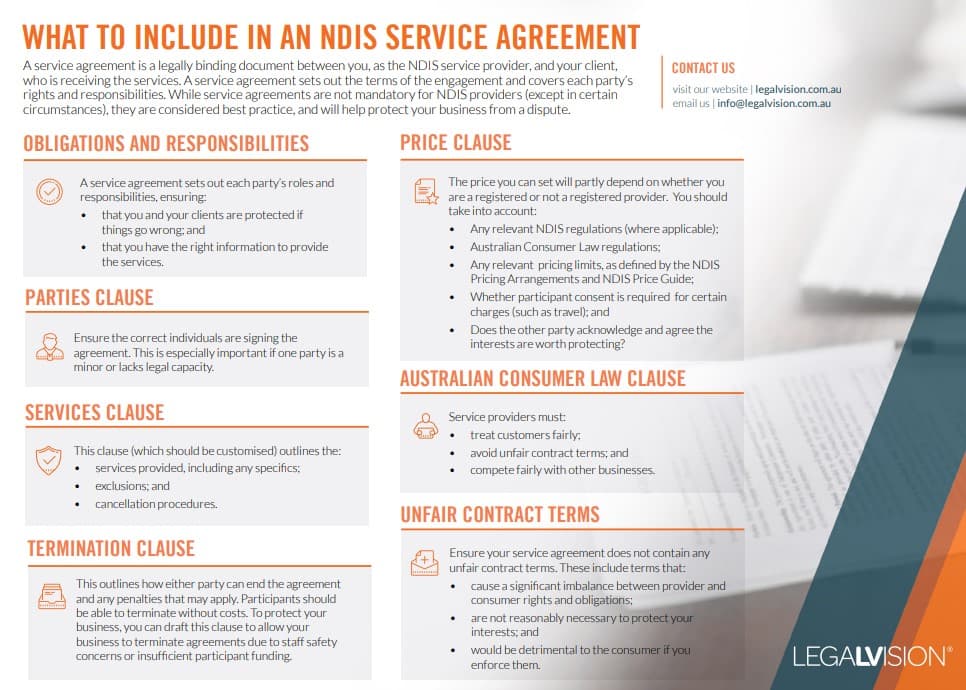In Short
- Facilities agreements enable medical practitioners to focus on patient care by outsourcing administrative tasks, facility maintenance, and essential services to a medical practice.
- These agreements clearly outline the obligations of both the practitioner and the medical practice, ensuring a mutual understanding of duties and expectations.
- Prior to entering into a facilities agreement, it’s crucial to assess factors such as fee structures, tax implications, insurance requirements, and any restraint clauses that may affect future practice opportunities.
Tips for Businesses
When drafting a facilities agreement, ensure that all services provided; such as administrative support, facility access, and equipment usage are clearly detailed. Define the fee structure, considering whether it will be a fixed rate or a percentage of billings. Additionally, address termination conditions and any restraint clauses to prevent future disputes and protect business interests.
A facilities agreement outlines the provision of facilities and administration services to a practitioner. A company, usually a medical practice, provides the services. Sometimes, this is also referred to as a medical or health care services agreement. Before entering into one, it is important to consider the key aspects of a facilities agreement, such as the types of services being offered, the compensation structure and termination conditions. This article will discuss what to look out for when entering into a facilities agreement.
Uses of a Facilities Agreement
Facilities agreements are frequently used by the medical industry, where health care practitioners often operate under the banner of a medical centre or company. These agreements outline the support services and resources the centre will provide to the practitioner. Typical services covered include:
- administration and support (such as receptionists);
- space: premises or rooms in which to practice;
- access to the practice’s patient management systems and other relevant software;
- essential medical equipment (for example, diagnostic tools, examination beds);
- maintenance of the space and/or equipment;
- clinical supplies and materials;
- IT services (e.g. a telephone and internet);
- payment collection and claim management services; and
- branding and marketing.
By outsourcing these operational aspects, medical practitioners can focus primarily on delivering high-quality care to their patients. The facilities agreement sets out the:
- terms of this relationship;
- rights, obligations and duties of each party; and
- relevant fees for the services.
While there is no legislative requirement to draft and enter into a facilities agreement, it is best practice to have the terms of the arrangement agreed upon in writing. This will ensure both parties are aware of their responsibilities. It is also important to have the terms of the arrangement clearly defined, particularly if any disputes arise down the track.
Obligations Within a Facilities Agreement
Facilities agreements should outline a clear set of obligations for both parties to uphold. Generally, the practitioner is expected to:
- follow all reasonable directions and policies set by the practice;
- provide and maintain high standards of professional care and service delivery;
- keep required accreditations, licenses and memberships up-to-date through continuing professional development; and
- avoid soliciting the practice’s patients for services at other premises (non-compete).
In return, the medical practice or company will ensure they:
- supply and maintain the facilities and administration services; and
- avoid interfering with or directing the practitioner’s services, clinical judgement and treatment decisions (unless expressly permitted, e.g. if the practice needs to manage a complaint).
These obligations are not particularly onerous on either party and form the basis of many facilities agreements – allowing practitioners to operate independently while ensuring they adhere to the practice’s reasonable policies for cohesive operations. The practice provides supportive infrastructure while respecting clinical independence.
Continue reading this article below the formImportant Considerations When Entering into a Facilities Agreement
Before entering into a facilities agreement, a party should always seek tax advice as there may be tax considerations (such as payroll tax). After obtaining tax advice, both the company and the practitioner should agree on the fixed rate of fee distribution.
Practices will need to understand and consider their financial arrangements, including the fees being charged.
Both parties should also ensure they hold and maintain adequate insurance for the services being provided.
Facilities agreements will also generally require the practitioner to hold and maintain a significant level of professional indemnity insurance (PII). It is not necessarily onerous. However, many agreements will require, due to the nature of the profession, a practitioner to continue to hold this insurance for a number of years following the termination of the agreement. Considering whether a practitioner is willing and able to continue to hold this level of PII is important when entering into the facilities agreement. The practitioner is also commonly required to hold and maintain workers compensation insurance. They also need to have public liability insurance (PLI).
A further consideration is the extent to which either party may seek to limit their own liability.

This fact sheet will help you to identify the key terms you must include in your NDIS service agreement.
Here is a table that breaks down the above:
| Factor | Considerations | Example |
| Tax Implications | Payroll tax, GST considerations, and other tax obligations | Seek advice on whether payroll tax applies to contracted practitioners |
| Fee Structure | Fixed fees vs. percentage-based billing | A GP may pay a 30% fee on billings instead of a fixed monthly rate |
| Insurance Requirements | Professional Indemnity Insurance (PII), Public Liability (PLI), Workers’ Compensation | A telehealth provider may require different coverage from an in-person practitioner |
| Liability Limitations | Defining each party’s liability in case of disputes or claims | A clinic may limit liability for IT failures affecting patient records |
| Restraint Clauses | Time-based, location-based, and client-solicitation restrictions | A 12-month, 10km restriction on opening a competing practice |
Restraints
Facilities agreements commonly feature restraints. These can be for particular time periods, distances or restrict the solicitation of clients. Restraints of this nature are often included to protect the ongoing business of the medical practice. They are also added to discourage practitioners from soliciting clients to move with them if they leave. These clauses are often drafted as cascading or waterfall clauses, for example:
“The Practitioner must not, within the restraint area for the restraint period;
- directly or indirectly, in any capacity, carry on or be engaged in any activity that provides the specified service;
- restraint area means;
- 100 kms from the premises; or
- 50 kms from the premises; or
- 25 kms from the premises; or
- 5 kms from the premises.
- restraint period means;
- 18 months following termination; or
- 1 year following termination; or
- 6 months following termination; or
- 3 months following termination.”
The cascading clause allows for the courts to consider whether a certain restraint is unreasonable. The courts may read down the clause until it becomes reasonable. A court might find 100 kms, 50 kms and 25 kms too restrictive on the practitioner. In this case, the medical practice may still enforce the remaining 5 kms clause. The enforceability of restraint clauses is certainly a grey area. It is advisable to have a legal professional provide advice and draft these clauses.
Key Takeaways
There are many other personal and professional considerations to take into account before you enter into a facilities agreement. You should also carefully consider restraints and how they may affect future opportunities. You should clearly document any arrangement and both parties should agree to the terms.
Whether you are looking to engage a medical practitioner for your practice or you are a medical practitioner yourself, our specialised legal team can assist you with drafting an appropriate agreement.
If you need assistance, our experienced contract lawyers can assist as part of our LegalVision membership. For a low monthly fee, you will have unlimited access to lawyers to answer your questions and draft and review your documents. Call us today on 1300 544 755 or visit our membership page.
Frequently Asked Questions
Before entering a facilities agreement, review the types of services offered, the fee structure, and the termination conditions. Seek tax advice, understand insurance requirements, and assess any restraints that could limit future opportunities. A well-drafted agreement ensures both parties are clear on their obligations.
A facilities agreement allows medical practitioners to focus on patient care while the practice handles administration, equipment, and support services. In exchange for a fixed fee or percentage of billings, practitioners gain access to essential resources, such as receptionists, IT systems, and clinical supplies, while retaining clinical independence.
We appreciate your feedback – your submission has been successfully received.











